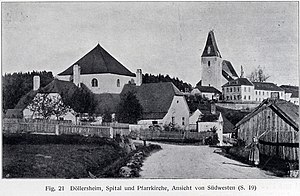Dollersheim
|
Döllersheim ( isolated settlement ) locality cadastral community Döllersheim |
||
|---|---|---|
|
|
||
| Basic data | ||
| Pole. District , state | Zwettl (ZT), Lower Austria | |
| Judicial district | Zwettl | |
| Pole. local community | Pölla | |
| Coordinates | 48 ° 37 '13 " N , 15 ° 18' 33" E | |
| Residents of the village | 0 (January 1, 2020) | |
| Building status | 2 (2001) | |
| Area d. KG | 5.48 km² | |
| Statistical identification | ||
| Locality code | 01311 | |
| Cadastral parish number | 24010 | |
| Counting district / district | Döllersheim (32520 005) | |
 View of Döllersheim, no later than 1911 |
||
| Source: STAT : index of places ; BEV : GEONAM ; NÖGIS | ||
Döllersheim has been a cadastral municipality of Pölla in Lower Austria since January 1st, 1964 with an area of 548.06 hectares. In order to be able to create the Döllersheim military training area , the residents were evacuated from 1938 onwards .
history
The heap village- like street settlement Döllersheim lay in a basin at the foot of the Donaberg and formed the intersection of numerous streets.
Döllersheim is indirectly mentioned for the first time around 1143, when a Chunradus de Tolersheim appears as a witness on a document from Duke Heinrich of Bavaria. A Rapoto de Tolrshaim, whose castle probably stood on the mountain next to the parish church of Döllersheim, appears as a further witness in 1272. It is not known when Döllersheim was made a market.
In 1427 Döllersheim was conquered and destroyed by the Hussites . In 1620 the market was burned down again.
Since the actual grave of Anna Maria Schicklgruber , Adolf Hitler's grandmother, who lived in Strones , could no longer be found in the Döllersheim cemetery, the community erected a much-visited honorary grave. The main square of Döllersheim was named Alois-Hitler-Platz after Adolf Hitler's father . In July 1939, Adolf Hitler was made an honorary citizen of the market.
The run of the parish Döllersheim since 1632 church records of births and since 1634 for marriages and deaths were after the lifting of the parish that of Rastenfeld handed over for safekeeping.
In order to be able to build the Döllersheim military training area, the resettlement of the population was planned by April 1, 1940; however, this date was postponed twice until October 31, 1941. The 392nd Infantry Division was set up in Döllersheim in 1943 as the last of three German-Croatian divisions .
After the Second World War, Austria was occupied by Allied forces from 1945 to 1955 , and the military training area in the Soviet zone was used by the Red Army for several years.
Since 1981 the former parish church of Döllersheim, the cemetery and the hospital are no longer in the restricted military area and can be visited. The church received simple ecclesiastical consecration on September 13, 1986 by Bishop Franz Žak . It is again under the patronage of the Apostles Peter and Paul, but was given the name Peace Church .
Buildings
The Austrian art topography names the parish church of Saints Peter and Paul , the citizens' hospital and the gallows , which was demolished in 1903 and used as gravel for road construction, as notable buildings in the formerly independent market in Döllersheim . Also mentioned is a chapel-like wayside shrine at the western entrance to the village with a polychrome statue of Johannes Nepomuk . In 1735 the community committed itself to the establishment and maintenance of this depiction of the saint in the Zwettl district.
literature
- Paul Buberl: The monuments of the political district Zwettl in Lower Austria (without Zwettl Abbey). Part 1: Allentsteig judicial district (= Austrian art topography . Vol. 8, 1). Commissioned by Anton Schroll & Co, Vienna 1911.
- Johannes Müllner: The desecrated homeland. 2nd Edition. Association Information Waldviertel, Allentsteig 1998, ISBN 3-9500294-0-0 .
- Margot Schindler : Having to go. The resettlement of the Döllersheim area (Lower Austria) 1938–1942. Folklore aspects (= publications of the Austrian Museum for Folklore 23). Austrian Museum for Folklore, Vienna 1988, ISBN 3-900359-38-5 .
- Ernst Werner Techow : The old home. Description of the Waldviertel around Döllersheim. Published by the Deutsche Ansiedlungsgesellschaft Berlin. Sudetendeutsche Verlags- und Druckerei-GmbH, Eger 1942.
Web links
Individual evidence
- ↑ a b c Müllner: The desecrated home.
- ↑ Statistics Austria: Directory of Lower Austria 2001.
- ↑ a b Techow: The old home.
- ↑ a b Buberl: Austrian Art Topography.
- ↑ Peter Broucek (Ed.): A General in the Twilight. The memories of Edmund Glaise von Horstenau. Vol. 3: German Plenipotentiary General in Croatia and witness to the fall of the “Thousand Years of Reich” (= publications of the Commission for Modern History of Austria. Vol. 76). Böhlau, Wien et al. 1988, ISBN 3-205-08749-6 , pp. 235, 348-349 .
- ↑ Friedenskirche in Döllersheim .



